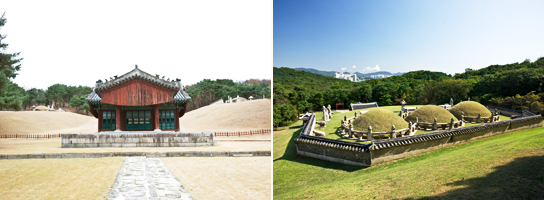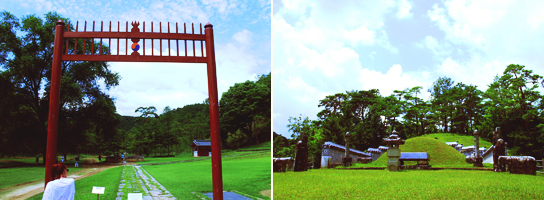29 Items in Jessica Jung's Bag: Selfie Stick, Disinfectant Wipes, Medicines, and Toilet Spray
Want to know what's inside Jessica Jung's bag? Let's check out the photos!

Kapanlagi.com - Some of you may have often heard of the Joseon Dynasty from Korean dramas or movies. Joseon itself was a kingdom founded by Taejo Daewangyang and lasted from 1392 to 1897. This kingdom was established after the fall of the Goryeo Dynasty, which ended after nearly 500 years of rule.
One of the legacies of the Joseon Dynasty is the royal tombs. It is very rare to have well-preserved royal tombs of a dynasty throughout the world after passing centuries. This is what led UNESCO to designate the area and ancestral ceremonies held at the site as a World Cultural Heritage to be remembered and to appreciate its cultural beauty.
The Royal Tombs of the Joseon Dynasty are the burial sites of the kings and queens of the Joseon Dynasty, which have a history of over 500 years. As quoted from KBS World, the existence of royal tombs with a history of more than 500 years without being destroyed is difficult to find a match in the world.
The total number of recorded tombs reaches 40 units. These tombs were then registered as UNESCO World Heritage Sites. Unfortunately, there are two tomb units that cannot be recorded because they are located in North Korea. These tombs are the tombs of kings and queens who received their titles after their death.

Grave of the Joseon Dynasty © Cultural Heritage Administration via KBS World
These tomb sites are located in lush green spaces on the outskirts of Seoul. This allows visitors to enjoy the natural and urban atmosphere at the same time.
These tombs were built to honor ancestors, show respect for their achievements, protect ancestral spirits from evil, and provide protection from vandalism.
These Royal Tombs were built based on Confucianism and Feng Shui. According to Feng Shui, royal tombs should be located in the right area with the principle of Baesanimsu, where there should be a river in the front and a mountain in the back. The location is surrounded by mountains to separate it from the surrounding area. In addition, most of the royal tombs are located around the capital Hanyang so that the king can make a pilgrimage there in one day.
That is why, as quoted from whc.unesco.org, these 40 tombs are spread across 18 locations. These tombs were built from 1408 to 1966. Most of these tombs are protected by hills at the back and face south and water. Not only that, mountains can also be seen in the distance.
The structure of the royal grave itself consists of three parts, namely the entrance hall which symbolizes the transient world (space for maintaining the Jaesil grave, pond, Geuncheongyo Bridge), the space for the living to worship the deceased (Hongsalmun gate, Jeongjagak pavilion, Subokbang preparation room for offering), and the last part is the sacred space for the deceased (pavilion for the Bigak epitaph monument, the bed of the king and queen inside the grave).
Not only that, after the Geumcheongyo Bridge that separates the transient world and the sacred space, there is a red Hongsalmun gate which represents the sacred place. In front of that gate, there is a road called Chamdo. Chamdo road is divided into two, namely the road used by the deceased king called Sindo, and the road used by the living king called Eodo. In front of the grave, there are also various statues and stone figures.

Seolleung Tomb (left) and Yungneung Tomb (right) © visitkorea.or.kr
Seonjeongneung, a site consisting of Seolleung Royal Tomb and Jeongneun Tomb. The tombs in this area are known for being peaceful and pleasant. Many office workers in downtown Seoul often visit this area for relaxation because of its peaceful atmosphere. They also refer to it as Samneung Park, which means Tomb Park.

Seooreung is the second largest royal burial site of the Joseon Dynasty after Donggureung, which means five tombs located in western Seoul. It is a memorial tomb of Crown Prince Uigyeong, who died young due to illness and was enshrined in Gyeongneung Tomb.
Donggureung is a historical site located in eastern Seoul. This site has nine royal tombs and appears larger compared to others, where a total of 17 kings and queens are buried here.

The last one is Jangneung, which is the tomb of the 6th king of Joseon, Danjong. King Danjong has a history where his throne was abdicated by his uncle. He left the palace to be exiled and spent the last years of his life in Yeongwol until his death. To mourn the tragedy, a tomb was built. However, his tomb is not like most other royal tombs, it is located farthest from the center. Nevertheless, its location apparently surrounded the tomb with green plants and guarded by a sacred gate called Hongsalmun (gate with red arrows).

Meanwhile, the Joseon Dynasty left a book that recorded all the processes of state ceremonies. The book is Uigwe which is related to national funeral ceremonies that record the procedures for determining the tomb site, calculating the required costs, materials used for the tomb, the timing of the funeral ceremony, and others. The book also contains very useful illustrations for maintaining and restoring the late king's funeral without any problems.
(kpl/mit)
Cobain For You Page (FYP) Yang kamu suka ada di sini,
lihat isinya
Want to know what's inside Jessica Jung's bag? Let's check out the photos!
Moonbyul MAMAMOO shares a creepy story about a ghost who disguised itself as Hwasa in her bed.
Song Hye Kyo did a short interview with W Korea magazine.
Lisa BLACKPINK once encountered a ghost that caused her to experience sleep paralysis. The ghost even sat on her bed and took the form of a man.
Because he admitted to liking Suho's song, Rian D'Masiv's Twitter was flooded by EXO-L and K-Pop fans.
Cha Eun Woo is known for his charming personality. But who would have thought that the ASTRO members would share an ugly photo of him on his birthday.
The end of the drama ITAEWON CLASS, caused Park Seo Joon to change his hairstyle. But netizens instead edited his photo to resemble seasonings. What does it look like?
Having been in a relationship, RM BTS becomes emotional as he recounts the reason for breaking up with his girlfriend. What was it?
Here are a series of super expensive branded bags owned by BLACKPINK members. Curious?
This Original Korean Calendar System was created in 1443, or the 15th year of King Sejong's reign during the Joseon Dynasty. What is the history behind its creation?
Have you ever heard of Arirang, a Korean folk song? Here are some interesting facts about Arirang.
Joseonmal Keunsajeon (Great Korean Language Dictionary) which became the first Korean language dictionary. The dictionary has been lost since it was confiscated by the police during the Japanese Occupation from 1910 to 1945. What is its history like?